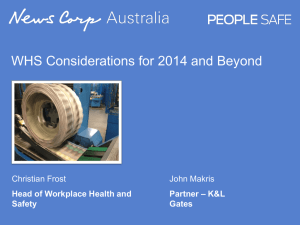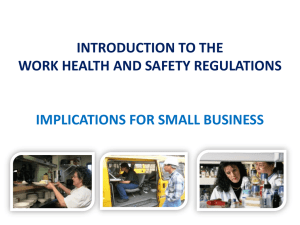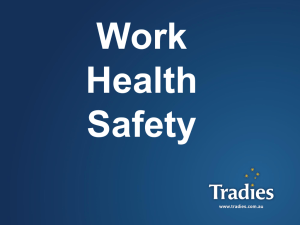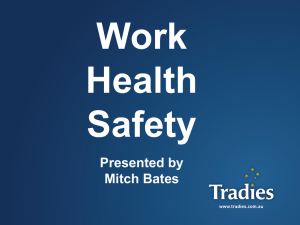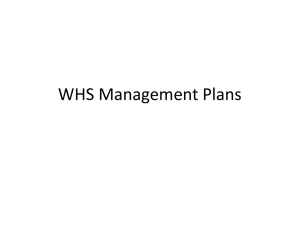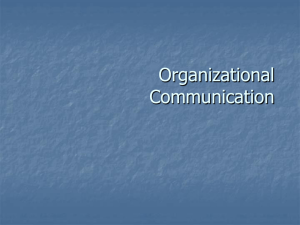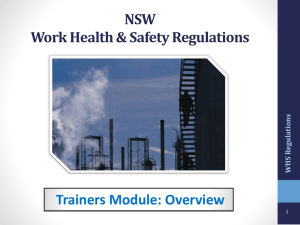WHS_Regulation_Training_Presentation-DW
advertisement
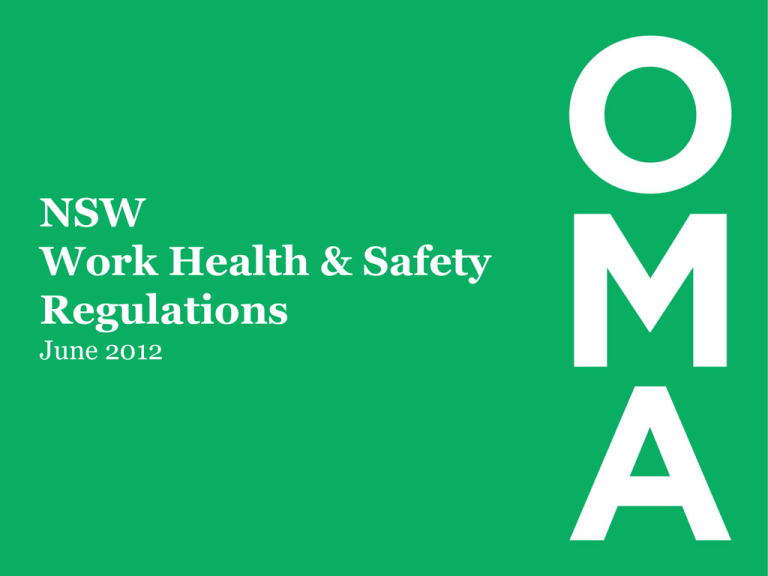
NSW Work Health & Safety Regulations June 2012 WHS Regulation Training Package Overview of Modules • • • • • • Recap on the WHS Act Overview of WHS Regulations Management of Risk and Workplace Management Common Workplace Hazards High Risk Hazards Construction Work Learning Outcomes The key learning outcomes of this course are: • An understanding of the legislative framework for WHS • An overview of the content and structure of the WHS Regulations • An understanding of how Codes of Practice are used to support the implementation of the WHS legislation • An understanding of the basic workplace requirements & management under the WHS Regulations An employer Is captured under the definition PCBU ‘person conducting a business or undertaking’ Controllers, self employed etc. Are also a PCBU with general duties of care General duties of Employers Will be subject to qualifier ‘reasonably practicable’ and will apply to all PCBUs and extend to all who are involved in the conduct of work Employees Are captured under the definition of worker which is broadly define to include anyone who carries out work in any capacity, including volunteers Duty of workers Workers have an expressed duty to take reasonable care of themselves at work Duty of others Others are required to take reasonable care when at a place of work Duty of Officers Will change from having an attributed liability to a positive duty of “due diligence” to ensure PCBU complies with duties Due diligence Is specifically defined and includes knowledge of WHS and business risks , allocation of resources, WHS reporting, compliance and verification processes Consultation Broadened to include all workers affected and other PCBUs with shared responsibilities OHS Representatives Replaced by health & safety representatives (HSR) with increased functions and powers HSR powers After completing approved training HSRs will be able to issue PINs and direct unsafe work to cease Management of Risk Risk assessments are not mandated in the Act but are mandated in the Regulation for certain high risk work Penalty Options Graduated enforcement options to include injunctions, remedial action and enforceable undertakings Penalties Criminal prosecution under this Act Maximum penalty for a corporation of $3 million and for an individual $300,000 & up to 5 years imprisonment for the most serious Class 1 breaches ELIMINATE RISKS (so far as is reasonably practicable) STOP USING OR CHANGE THE PRODUCT, PROCESS, PLANT OR SUBSTANCE STOP OR CHANGE THE ACTIVITY, PRACTICE OR PROCEDURE MINIMISE RISKS (so far as is reasonably practicable) SUBSTITUTE WITH SAFER ALTERNATIVE USE ENGINEERING CONTROLS REDESIGN TO REDUCE RISK ISOLATE PEOPLE FROM RISK USE ADMINISTRATIVE PROCEDURES USE PROTECTIVE CLOTHING / EQUIPMENT 1 Legislative Framework ACT Regulation Codes of Practice Function of the WHS Regulation The most important function of the WHS Regulations is to specify the steps that are required for compliance with the general duties under the Act What’s covered in the WHS Regulations PRELIMINARY REPRESENTATION AND PARTICIPATION GENERAL RISK & WORKPLACE MANAGEMENT HAZARDOUS WORK PLANT AND STRUCTURES What’s covered in the WHS Regulations CONSTRUCTION WORK HAZARDOUS CHEMICALS ASBESTOS MAJOR HAZARDOUS FACILITIES MINES GENERAL Some thing may appear to be missing Abrasive blasting Licensing for load shifting equipment Some construction hazards e.g. lowering of materials Welding Spray Painting Certificates of competency for pest control Identification and Management of Risk What is reasonably practicable - state of knowledge Some thing may appear to be missing REMEMBER: JUST BECAUSE A HAZARD IS NOT MENTIONED IN THE REGULATIONS DOES NOT MEAN IT IS NOT REGULATED. Any workplace hazard that is not specifically regulated is covered by the general duties in the WHS Act and Chapter 3 of the WHS Regulations. Duty holders (PCBUs and others) must identify any risk associated with the particular hazard and as far as is reasonably practicable, take steps to eliminate or minimise the risk. What is the legal effect of Codes of Practice? • Admissible in court proceedings under the WHS Act and Regulations • May be relied on by courts as evidence of what is known about a hazard, risk or control and in determining what is reasonably practicable • Designed to be used in conjunction with the WHS Act and Regulations but do not have the same legal implications • WHS Act and Regulations may be complied with by following another method if it provides an equivalent or higher standard • An inspector may refer to an approved Code of Practice when issuing an improvement or prohibition notice Codes of Practice SOME PRIORITY CODES RELEVANT TO OUR INDUSTRY How to manage work health safety risks WHS Consultation, Cooperation & Coordination Managing work environment and facilities Managing noise and preventing hearing loss at work Hazardous manual tasks How to prevent falls at workplaces Preparation of safety data sheets for hazardous chemicals Labelling workplace hazardous chemicals Second Stage Codes of Practice and Guidance Material relevant to our industry First Aid in the Workplace Managing Risks in Construction Work Managing Electrical Risks at the Workplace Welding and Allied Processes Managing Risks of Hazardous Chemicals Preventing and Responding to Workplace Bullying Managing Risks of Plant in the Workplace Preventing and Managing Fatigue in the Workplace Safe Design of Building and Structures Transitional arrangements and WorkCover NSW Codes Existing NSW Codes of Practice will continue to operate until replaced by national Codes of Practice or guidance materials or revoked For exampleWork Near Overhead Power Lines: Code of Practice Where NSW has a Code of Practice on issues that are not specifically regulated, these Codes will become guidance material and must be considered when deciding what is “reasonably practicable” Workplace WHS Requirements Managing Risks •Risks must be identified and controlled •Always aim to eliminate risks, and if not reasonably practicable then minimise risks as far as reasonably practical using the hierarchy of control •Risk assessment are not mandatory but must be outcome focused •Regularly maintain and review risk control measures Managing Risks • Further guidance about managing risk can be found in the Code of Practice • How to manage work health safety risks • The Code of Practice also includes guidance on risk assessment Consultation and Representation • The WHS Regulations: − Outlines the factors in determining work groups − Specifies HSR training details • The Code of Practice: Work Health and Safety Consultation, Cooperation and Coordination provides guidance on implementation and ongoing compliance Issue Resolution Procedure must take into account: the degree and immediacy of risk to workers or other persons involved in the issue; the number and location of workers and other persons affected by the issue; the measures (both temporary and permanent) that must be implemented to resolve the issue; who will be responsible for implementing the resolution measures Training, Information & Instruction Must be suitable and reflect: • The nature of the work carried out by the worker • The nature of the risks associated with the work • The control measures implemented Working Environment • Workplace layout allows persons to move around and access and exit without risk • Work space is adequate for the task • Floors and other surfaces are suitable • Lighting and ventilation is suitable • Work in temperature extremes is without risk • Work near essential services does not create risks The WHS Regulations specifies in detail the requirements for : Facilities •Including toilets, drinking water, washing and eating facilities • Must be appropriate to the activity and hazard, suitable size and fit and maintained and replaced as required. PPE First Aid Remote or Isolated Work • Workers must be informed and trained on PPE use • • • • • First Aid arrangements must take into account The nature of the work The hazards in the workplace The size, location and nature of the workplace The number and composition of workers (and others) • Must provide a system of work that includes effective communication with the worker • Must manage risks to the health and safety of a worker associated with remote or isolated work Falling Objects • • • • Must manage risks of falling objects if reasonably likely to injure a person If not possible to eliminate risk then minimise risks to health and safety by: Preventing free fall of objects Arresting free fall of object (e.g. barriers, safe means of lowering objects) Emergency Plans • The WHS Regulation specifies the requirement for Emergency Plans • They must include procedures for rapid response, evacuation, notification, medical assistance and communication • Must inform workers of procedures • Must be tested in line with plan schedules • Emergency plan must take into account − The nature of the work − The hazards in the workplace − The size, location and nature of the workplace − The number and composition of workers (and others) Common WHS Hazards What are common hazards? The common hazards likely to be found in most workplaces are considered to be: • Electrical work • Falls • Hazardous manual tasks • Plant and Structures • Hazardous chemicals Electrical Safety: Equipment and Installations PCBU must • Ensure unsafe electrical equipment disconnected and repaired or replaced • Inspect and test equipment • Keep records of testing until next tested or permanently removed Electrical Safety: Energised Electrical Equipment • Work on energised electrical equipment is prohibited except in certain circumstances • Must determine whether equipment is energised • De-energised equipment must not be inadvertently reenergised Hazardous Manual Tasks Take into account risk factors including: • Postures, force, duration and frequency • Workplace environmental conditions, design and layout of workplace • Systems of work used • Nature, size, weight and number of persons, animals or things involved in the hazardous manual task Hazardous Chemicals • Correctly label hazardous chemicals used in the workplace • Obtain and provide access to Safety Data Sheets (SDS) for workers • Maintain a register of hazardous chemicals used at the workplace • Display safety signs • Provide information, training and supervision to workers • Identify risks of physical or chemical reaction • Keep chemicals isolated and stable • Eliminate or minimise ignition sources Plant and Structures • Controls risks in commissioning and de-commissioning of plant • Ensure competent persons are used, provide information and undertake inspections • If guarding is used to control risks a hierarchy from fixed or interlocked to presence guards is followed • Ensure that plant not in use does not create a risk to the health or safety of any person • Ensure that the maintenance, repair, inspection and, if necessary, testing of the plant is carried out by a competent person and in accordance with manufacturer specifications High Risk Hazards Learning Outcomes The key learning outcomes of this module are: • An understanding of the high risk hazards, including licensing arrangements for high risk work covered in the WHS Regulations • An understanding of the changes from the current NSW OHS Regulations What is high risk work? high risk work means any work within the scope of a high risk work licence high risk work licence means any of the licences listed in Schedule 3 High Risk Work Relevant to our industry includes Means construction work that:(abbreviated from schedule 3) Involves a risk of a person falling more than 2 metres, Is carried out on, in or adjacent to a road, railway, shipping lane Or other traffic corridor that is in use by traffic other than Pedestrians, or Is carried out in an area at a workplace in which there is any movement of powered mobile plant, Is carried out on or near energised electrical installations or Services Work Near Traffic • Ensure that a worker is not exposed to risk from working near traffic • Safe systems and methods of work must be established for any worker carrying out work on, in or adjacent to a road, railway or other traffic corridor that is in use by traffic other than pedestrians Electrical Safety Overhead Electrical Lines • Ensure that no person, plant or thing at the workplace comes within an unsafe distance of an overhead or underground electric line • If it is not reasonably practicable to comply, conduct a risk assessment Falls Manage the risk of a fall by a person from one level to another by: • Ensuring so far as is reasonably practicable that any work that involves the risk of a fall is carried out on the ground or on a solid construction • Providing safe access to and exit from the workplace or any area within the workplace with the risk of a fall If not reasonably practicable to eliminate the risk of falling then minimise the risk by providing adequate protection such as (in order): • Providing a fall prevention device or • Providing a work positioning system or • Providing a fall arrest system Mobile Plant Ensure that works involving mobile plant are • Conducted by competent persons following safe systems of works • Able to be done at a safe distance and separation from any persons in the vicinity • Are done using regularly inspected and maintained equipment High Risk Work – Licensing A PCBU must ensure: Direct Supervision • Direct supervision of person carrying out work, unless to do so is impracticable or unnecessary and reduced supervision does not cause risk to any person Evidence of Licence • Written evidence that the worker has the relevant high risk work licence • Written evidence that the supervisor holds relevant license • Must keep records for 1 yr Construction Specific Requirements WHS Regulations Chapter 6 Construction Work • • • • • • • • CHANGES Definition of construction work Principal Contractor duties Construction induction Duties of designers of structures The following has been moved into the chapter on Plant & Structures Overhead protective structures Structural collapse Safe lowering of materials Definition of Construction Work Construction work means: “any work carried out in connection with the construction, alteration, conversion, fitting-out, commissioning, renovation, repair, maintenance, refurbishment, demolition, decommissioning or dismantling of a structure” Construction Work Includes activities connected with: The demolition and installation of billboard structures Onsite Installation of advertising structures such as bus stops and benches Construction Work does NOT include: The manufacture of plant, including fixed plant Prefabrication of elements off site for use in construction The construction or assembly of a structure to be transported to another place Testing, maintenance or repair work of a minor nature connected with a structure WHAT IS A CONSTRUCTION PROJECT WHO IS THE PRINCIPAL CONTRACTOR • A construction project is a project that involves construction work where the cost of the construction work is $250 000 or more • The PCBU that commissions a construction project is the principal contractor Safe Work Method Statements Safe Work Method Statements (SWMS) are required for ALL HIGH RISK CONSTRUCTION WORK and must be prepared before work commences. SWMS must: Identify work that is high risk construction work Specify hazards and risks associated with that work Describe measures to control risks Describe how the risk control measures are to be implemented, monitored and reviewed Safe Work Method Statements Compliance PCBU must give a copy to the Principal Contractor before work commences PCBU must put in place arrangements to ensure SWMS is followed If high risk construction work is not carried out in accordance with the SWMS, the work MUST be: −stopped immediately or as soon as safe to do so; −resumed in accordance with the statement Person who comminsions work MUST: • Consult with the designer about how to ensure risks arising from the design during construction work are: • Eliminated, so far as is reasonably practicable, or • Minimised, so far as is reasonably practicable • Give the designer and the principal contractor information regarding hazards and risks Design Safety Report Must account for: maintenance, refurbishment, demolition and dismantling of a structure Must specify hazards that may create risks not only during initial building but to workers who undertake maintenance or demolition work in the future General Construction Induction PCBUs must ensure that: • General induction training is provided to relevant workers • Workers have been trained before directing or allowing a worker to carry out construction work Workers must: • Keep their general induction training card available for inspection Questions
